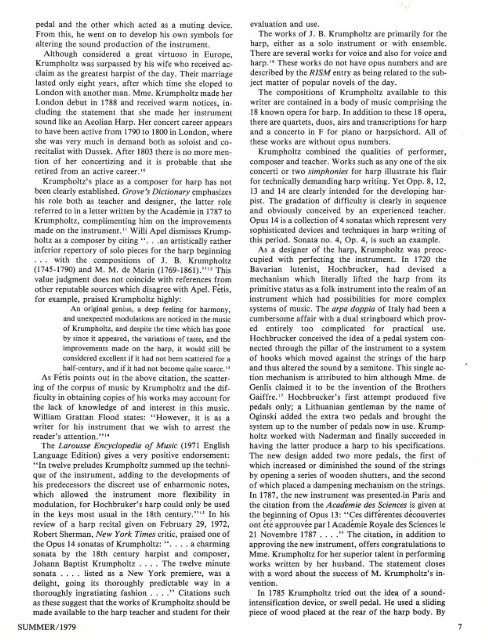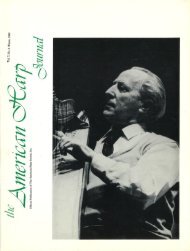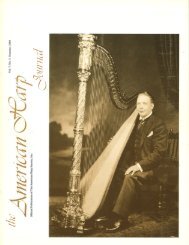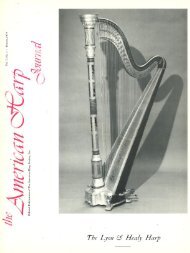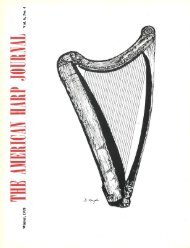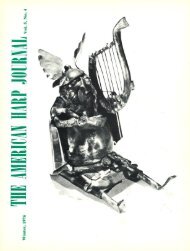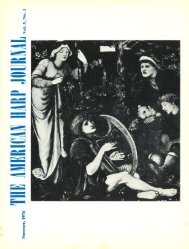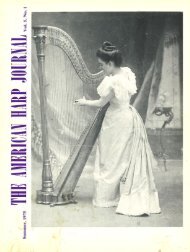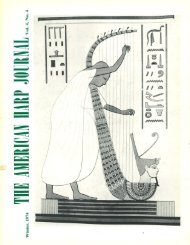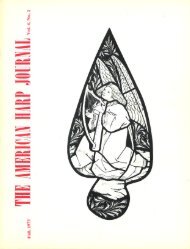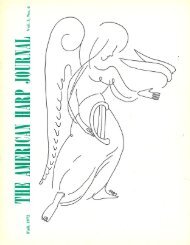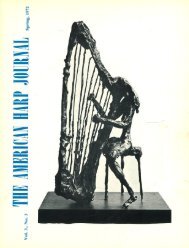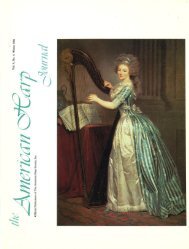AHJ, Vol. 7 No. 1, Summer 1979
AHJ, Vol. 7 No. 1, Summer 1979
AHJ, Vol. 7 No. 1, Summer 1979
You also want an ePaper? Increase the reach of your titles
YUMPU automatically turns print PDFs into web optimized ePapers that Google loves.
pedal and the other which acted as a muting device.<br />
From this, he went on to develop his own symbols for<br />
altering the sound production of the instrument.<br />
Although considered a great virtuoso in Europe,<br />
Krumpholtz was surpassed by his wife who received acclaim<br />
as the greatest harpist of the day. Their marriage<br />
lasted only eight years, after which time she eloped to<br />
London with another man. Mme. Krumpholtz made her<br />
London debut in 1788 and received warm notices, including<br />
the statement that she made her instrument<br />
sound like an Aeolian Harp. Her concert career appears<br />
to have been active from 1790 to 1800 in London, where<br />
she was very much in demand both as soloist and corecitalist<br />
with Dussek. After 1803 there is no more mention<br />
of her concertizing and it is probable that she<br />
retired from an active career. 10<br />
Krumpholtz's place as a composer for harp has not<br />
been clearly established. Grove's Dictionary emphasizes<br />
his role both as teacher and designer, the latter role<br />
referred to in a letter written by the Academie in 1787 to<br />
Krumpholtz, complimenting him on the improvements<br />
made on the instrument. 11 Willi Apel dismisses Krumpholtz<br />
as a composer by citing " ... an artistically rather<br />
inferior repertory of solo pieces for the harp beginning<br />
. . . with the compositions of J. B. Krumpholtz<br />
(1745-1790) and M. M. de Marin (1769-1861)." 12 This<br />
value judgment does not coincide with references from<br />
other reputable sources which disagree with Apel. F~tis,<br />
for example, praised Krumpholtz highly:<br />
An original genius, a deep feeling for harmony,<br />
and unexpected modulations are noticed in the music<br />
of Krumpholtz, and despite the time which has gone<br />
by since it appeared, the variations of taste, and the<br />
improvements made on the harp, it would still be<br />
considered excellent if it had not been scattered for a<br />
half-century, and if it had not become quite scarce.''<br />
As Fetis points out in the above citation, the scattering<br />
of the corpus of music by Krumpholtz and the difficulty<br />
in obtaining copies of his works may account for<br />
the lack of knowledge of and interest in this music.<br />
William Grattan Flood states: "However, it is as a<br />
writer for his instrument that we wish to arrest the<br />
reader's attention." 14<br />
The Larousse Encyclopedia of Music (1971 English<br />
Language Edition) gives a very positive endorsement:<br />
"In twelve preludes Krumpholtz summed up the technique<br />
of the instrument, adding to the developments of<br />
his predecessors the discreet use of enharmonic notes,<br />
which allowed the instrument more flexibility in<br />
modulation, for Hochbruker's harp could only be used<br />
in the keys most usual in the 18th century." 1 5 In his<br />
review of a harp recital given on February 29, 1972,<br />
Robert Sherman, New York Times critic, praised one of<br />
the Opus 14 sonatas of Krumpholtz: " .... a charming<br />
sonata by the 18th century harpist and composer,<br />
Johann Baptist Krumpholtz .... The twelve minute<br />
sonata . . . . listed as a New York premiere, was a<br />
delight, going its thoroughly predictable way in a<br />
thoroughly ingratiating fashion . . . . '' Citations such<br />
as these suggest that the works of Krumpholtz should be<br />
made available to the harp teacher and student for their<br />
SUMMER/ <strong>1979</strong><br />
evaluation and use.<br />
The works of J. B. Krumpholtz are primarily for the<br />
harp, either as a solo instrument or with ensemble.<br />
There are several works for voice and also for voice and<br />
harp. 1 • These works do not have opus numbers and are<br />
described by the RISM entry as being related to the subject<br />
matter of popular novels of the day.<br />
The compositions of Krumpholtz available to this<br />
writer are contained in a body of music comprising the<br />
18 known opera for harp. In addition to these 18 opera,<br />
there are quartets, duos, airs and transcriptions for harp<br />
and a concerto in F for piano or harpsichord. All of<br />
these works are without opus numbers.<br />
Krumpholtz combined the qualities of performer,<br />
composer and teacher. Works such as any one of the six<br />
concerti or two simphonies for harp illustrate his flair<br />
for technically demanding harp writing. Yet Opp. 8, 12,<br />
13 and 14 are clearly intended for the developing harpist.<br />
The gradation of difficulty is clearly in sequence<br />
and obviously conceived by an experienced teacher.<br />
Opus 14 is a collection of 4 sonatas which represent very<br />
sophisticated devices and techniques in harp writing of<br />
this period. Sonata no. 4, Op. 4, is such an example.<br />
As a designer of the harp, Krumpholtz was preoccupied<br />
with perfecting the instrument. In I 720 the<br />
Bavarian lutenist, Hochbrucker, had devised a<br />
mechanism which literally lifted the harp from its<br />
primitive status as a folk instrument into the realm of an<br />
instrument which had possibilities for more complex<br />
systems of music. The arpa doppia of Italy had been a<br />
cumbersome affair with a dual stringboard which proved<br />
entirely too complicated for practical use.<br />
Hochbrucker conceived the idea of a pedal system connected<br />
through the pillar of the instrument to a system<br />
of hooks which moved against the strings of the harp<br />
and thus altered the sound by a semitone. This single action<br />
mechanism is attributed to him although Mme. de<br />
Genlis claimed it to be the invention of the Brothers<br />
Gaiffre. 11 Hochbrucker' s first attempt produced five<br />
pedals only; a Lithuanian gentleman by the name of<br />
Oginski added the extra two pedals and brought the<br />
system up to the number of pedals now in use. Krumpholtz<br />
worked with Naderman and finally succeeded in<br />
having the latter produce a harp to his specifications.<br />
The new design added two more pedals, the first of<br />
which increased or diminished the sound of the strings<br />
by opening a series of wooden shutters, and the second<br />
of which placed a dampening mechanism on the strings.<br />
In 1787, the new instrument was presented.in Paris and<br />
the citation from the Academie des Sciences is given at<br />
the beginning of Opus 13: "Ces differentes decouvertes<br />
ont ete approuvee par 1 Academie Royale des Sciences le<br />
21 <strong>No</strong>vembre 1787 ...." The citation, in addition to<br />
approving the new instrument, offers congratulations to<br />
Mme. Krumpholtz for her superior talent in performing<br />
works written by her husband. The statement closes<br />
with a word about the success of M. Krumpholtz's invention.<br />
In 1785 Krumpholtz tried out the idea of a soundintensification<br />
device, or swell pedal. He used a sliding<br />
piece of wood placed at the rear of the harp body. By<br />
7


